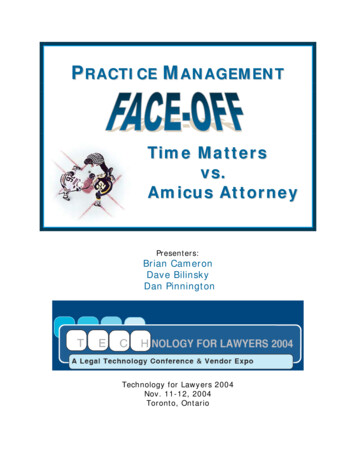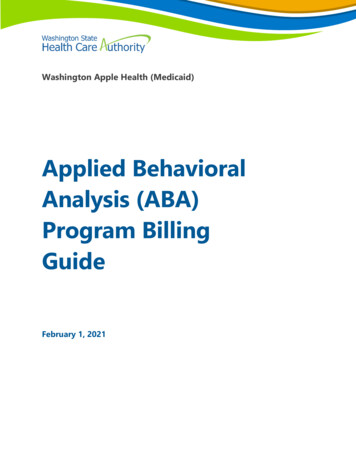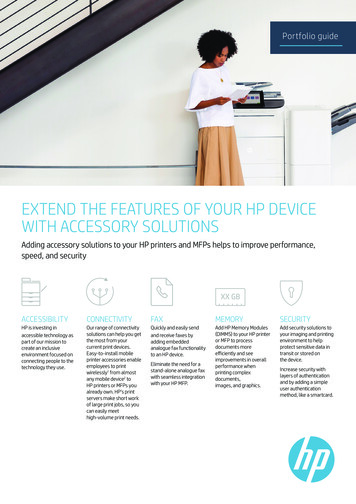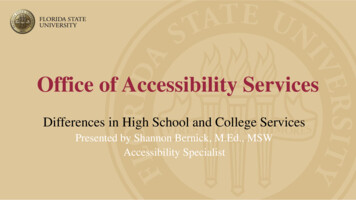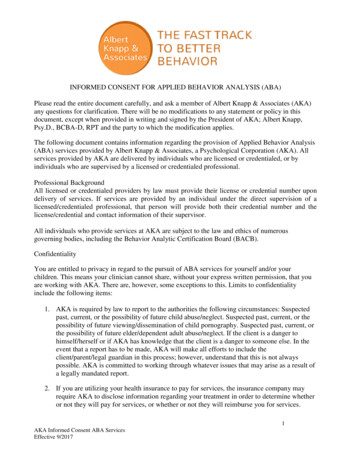
Transcription
ABA Accessibility Standards for Federal FacilitiesABA Accessibility Standard for Department of Defense FacilitiesGuide to the ADA and ABA StandardsThese standards apply to Department of Defense (DOD) facilities under theArchitectural Barriers Act (ABA) as of October 31, 2008. DOD adopted thesestandards based on updated guidelines issued by the Board.Related Document: DOD memorandum adopting these standardsTable of Contents1.2.3.4.5.6.7.8.9.10.11.ABA Chapter 1: Application and AdministrationABA Chapter 2: Scoping RequirementsChapter 3: Building BlocksChapter 4: Accessible RoutesChapter 5: General Site and Building ElementsChapter 6: Plumbing Elements and FacilitiesChapter 7: Communication Elements and FeaturesChapter 8: Special Rooms, Spaces and ElementsChapter 9: Built-In ElementsChapter 10: Recreation FacilitiesFigure IndexABA Chapter 1: Application and Administration F101F102F103F104F105F106PurposeDimensions for Adults and ChildrenModifications and WaiversConventionsReferenced StandardsDefinitionsF101 PurposeThis document contains scoping and technical requirements for accessibility to sites, facilities,buildings, and elements by individuals with disabilities. The requirements are to be applied during ds-dod.cfm (1 of 212) [6/1/2009 8:22:40 AM]
ABA Accessibility Standards for Federal Facilitiesdesign, construction, addition to, alteration, and lease of sites, facilities, buildings, and elements tothe extent required by regulations issued by Federal agencies under the Architectural Barriers Act of1968 (ABA).F102 Dimensions for Adults and ChildrenThe technical requirements are based on adult dimensions and anthropometrics. In addition, thisdocument includes technical requirements based on children's dimensions and anthropometrics fordrinking fountains, water closets, toilet compartments, lavatories and sinks, dining surfaces, and worksurfaces.F103 Modifications and WaiversThe Architectural Barriers Act authorizes the Administrator of the General Services Administration, theSecretary of the Department of Housing and Urban Development, the Secretary of the Department ofDefense, and the United States Postal Service to modify or waive the accessibility standards forbuildings and facilities covered by the Architectural Barriers Act on a case-by-case basis, uponapplication made by the head of the department, agency, or instrumentality of the United Statesconcerned. The General Services Administration, the Department of Housing and Urban Development,the Department of Defense, and the United States Postal Service may grant a modification or waiveronly upon a determination that it is clearly necessary. Section 502(b)(1) of the Rehabilitation Act of1973 authorizes the Access Board to ensure that modifications and waivers are based on findings offact and are not inconsistent with the Architectural Barriers Act.Advisory F103 Modifications and Waivers. The provisions for modifications and waivers differ fromthe requirement issued under the Americans with Disabilities Act in that "equivalent facilitation"does not apply. There is a formal procedure for Federal agencies to request a waiver or modificationof applicable standards under the Architectural Barriers Act.F104 ConventionsF104.1 Dimensions. Dimensions that are not stated as "maximum" or "minimum" are absolute.F104.1.1 Construction and Manufacturing Tolerances. All dimensions are subject to conventionalindustry tolerances except where the requirement is stated as a range with specific minimum andmaximum end points.Advisory F104.1.1 Construction and Manufacturing Tolerances. Conventional industry tolerancesrecognized by this provision include those for field conditions and those that may be a necessaryconsequence of a particular manufacturing process. Recognized tolerances are not intended toapply to design work.It is good practice when specifying dimensions to avoid specifying a tolerance where dimensions areabsolute. For example, if this document requires "1 inches," avoid specifying "1 inches plus orminus X inches."Where the requirement states a specified range, such as in Section 609.4 where grab bars must beinstalled between 33 inches and 36 inches above the floor, the range provides an adequatetolerance and therefore no tolerance outside of the range at either end point is standards-dod.cfm (2 of 212) [6/1/2009 8:22:40 AM]
ABA Accessibility Standards for Federal FacilitiesWhere a requirement is a minimum or a maximum dimension that does not have two specificminimum and maximum end points, tolerances may apply. Where an element is to be installed atthe minimum or maximum permitted dimension, such as "15 inches minimum" or "5 poundsmaximum", it would not be good practice to specify "5 pounds (plus X pounds) or 15 inches (minusX inches)." Rather, it would be good practice to specify a dimension less than the required maximum(or more than the required minimum) by the amount of the expected field or manufacturingtolerance and not to state any tolerance in conjunction with the specified dimension.Specifying dimensions in design in the manner described above will better ensure that facilities andelements accomplish the level of accessibility intended by these requirements. It will also moreoften produce an end result of strict and literal compliance with the stated requirements andeliminate enforcement difficulties and issues that might otherwise arise. Information on specifictolerances may be available from industry or trade organizations, code groups and building officials,and published references.F104.2 Calculation of Percentages. Where the required number of elements or facilities to be providedis determined by calculations of ratios or percentages and remainders or fractions result, the nextgreater whole number of such elements or facilities shall be provided. Where the determination of therequired size or dimension of an element or facility involves ratios or percentages, rounding down forvalues less than one half shall be permitted.F104.3 Figures. Unless specifically stated otherwise, figures are provided for informational purposesonly.Figure F104Graphic Convention for ndards-dod.cfm (3 of 212) [6/1/2009 8:22:40 AM]
ABA Accessibility Standards for Federal FacilitiesF105 Referenced StandardsF105.1 General. The standards listed in F105.2 are incorporated by reference in this document andare part of the requirements to the prescribed extent of each such reference. The Director of theFederal Register has approved these standards for incorporation by reference in accordance with 5 U.S.C. 552(a) and 1 CFR part 51. Copies of the referenced standards may be inspected at theArchitectural and Transportation Barriers Compliance Board, 1331 F Street, NW, Suite 1000,Washington, DC 20004; at the Department of Justice, Civil Rights Division, Disability Rights Section,1425 New York Avenue, NW, Washington, DC; at the Department of Transportation, 400 SeventhStreet, SW, Room 10424, Washington DC; or at the National Archives and Records Administration(NARA). For information on the availability of this material at NARA, call 202-741-6030, or go tohttp://www.archives.gov/federal register/code of federal regulations/ibr locations.html.F105.2 Referenced Standards. The specific edition of the standards listed below are referenced in thisdocument. Where differences occur between this document and the referenced standards, thisdocument andards-dod.cfm (4 of 212) [6/1/2009 8:22:40 AM]
ABA Accessibility Standards for Federal FacilitiesF105.2.1 ANSI/BHMA. Copies of the referenced standards may be obtained from the BuildersHardware Manufacturers Association, 355 Lexington Avenue, 17th floor, New York, NY 10017(http://www.buildershardware.com).ANSI/BHMA A156.10-1999 American National Standard for Power Operated Pedestrian Doors (see404.3).ANSI/BHMA A156.19-1997 American National Standard for Power Assist and Low Energy PowerOperated Doors (see 404.3, 408.3.2.1, and 409.3.1).ANSI/BHMA A156.19-2002 American National Standard for Power Assist and Low Energy PowerOperated Doors (see 404.3, 408.3.2.1, and 409.3.1).Advisory F105.2.1 ANSI/BHMA. ANSI/BHMA A156.10-1999 applies to power operated doors forpedestrian use which open automatically when approached by pedestrians. Included are provisionsintended to reduce the chance of user injury or entrapment.ANSI/BHMA A156.19-1997 and A156.19-2002 applies to power assist doors, low energy poweroperated doors or low energy power open doors for pedestrian use not provided for in ANSI/BHMAA156.10 for Power Operated Pedestrian Doors. Included are provisions intended to reduce thechance of user injury or entrapment.F105.2.2 ASME. Copies of the referenced standards may be obtained from the American Society ofMechanical Engineers, Three Park Avenue, New York, New York 10016 (http://www.asme.org).ASME A17.1- 2000 Safety Code for Elevators and Escalators, including ASME A17.1a-2002 Addendaand ASME A17.1b-2003 Addenda (see 407.1, 408.1, 409.1, and 810.9).ASME A18.1-1999 Safety Standard for Platform Lifts and Stairway Chairlifts, including ASME A18.1a2001 Addenda and ASME A18.1b-2001 Addenda (see 410.1).ASME A18.1-2003 Safety Standard for Platform Lifts and Stairway Chairlifts, (see 410.1).Advisory F105.2.2 ASME. ASME A17.1-2000 is used by local jurisdictions throughout the UnitedStates for the design, construction, installation, operation, inspection, testing, maintenance,alteration, and repair of elevators and escalators. The majority of the requirements apply to theoperational machinery not seen or used by elevator passengers. ASME A17.1 requires a two-waymeans of emergency communications in passenger elevators. This means of communication mustconnect with emergency or authorized personnel and not an automated answering system. Thecommunication system must be push button activated. The activation button must be permanentlyidentified with the word "HELP." A visual indication acknowledging the establishment of acommunications link to authorized personnel must be provided. The visual indication must remainon until the call is terminated by authorized personnel. The building location, the elevator carnumber, and the need for assistance must be provided to authorized personnel answering theemergency call. The use of a handset by the communications system is prohibited. Only theauthorized personnel answering the call can terminate the call. Operating instructions for thecommunications system must be provided in the elevator car.The provisions for escalators require that at least two flat steps be provided at the entrance and rds-dod.cfm (5 of 212) [6/1/2009 8:22:40 AM]
ABA Accessibility Standards for Federal Facilitiesof every escalator and that steps on escalators be demarcated by yellow lines 2 inches widemaximum along the back and sides of steps.ASME A18.1-1999 and ASME A18.1-2003 address the design, construction, installation, operation,inspection, testing, maintenance and repair of lifts that are intended for transportation of personswith disabilities. Lifts are classified as: vertical platform lifts, inclined platform lifts, inclined stairwaychairlifts, private residence vertical platform lifts, private residence inclined platform lifts, andprivate residence inclined stairway chairlifts.This document does not permit the use of inclined stairway chairlifts which do not provide platformsbecause such lifts require the user to transfer to a seat.ASME A18.1 contains requirements for runways, which are the spaces in which platforms or seatsmove. The standard includes additional provisions for runway enclosures, electrical equipment andwiring, structural support, headroom clearance (which is 80 inches minimum), lower level accessramps and pits. The enclosure walls not used for entry or exit are required to have a grab bar thefull length of the wall on platform lifts. Access ramps are required to meet requirements similar tothose for ramps in Chapter 4 of this document.Each of the lift types addressed in ASME A18.1 must meet requirements for capacity, load, speed,travel, operating devices, and control equipment. The maximum permitted height for operable partsis consistent with Section 308 of this document. The standard also addresses attendant operation.However, Section 410.1 of this document does not permit attendant operation.F105.2.3 ASTM. Copies of the referenced standards may be obtained from the American Society forTesting and Materials, 100 Bar Harbor Drive, West Conshohocken, Pennsylvania 19428 (http://www.astm.org).ASTM F 1292-99 Standard Specification for Impact Attenuation of Surface Systems Under and AroundPlayground Equipment (see 1008.2.6.2).ASTM F 1292-04 Standard Specification for Impact Attenuation of Surfacing Materials Within the UseZone of Playground Equipment (see 1008.2.6.2).ASTM F 1487-01 Standard Consumer Safety Performance Specification for Playground Equipment forPublic Use (see F106.5).ASTM F 1951-99 Standard Specification for Determination of Accessibility of Surface Systems Underand Around Playground Equipment (see 1008.2.6.1).Advisory F105.2.3 ASTM. ASTM F 1292-99 and ASTM F 1292-04 establish a uniform means tomeasure and compare characteristics of surfacing materials to determine whether materials providea safe surface under and around playground equipment. These standards are referenced in the playareas requirements of this document when an accessible surface is required inside a play area usezone where a fall attenuating surface is also required. The standards cover the minimum impactattenuation requirements, when tested in accordance with Test Method F 355, for surface systemsto be used under and around any piece of playground equipment from which a person may fall.ASTM F 1487-01 establishes a nationally recognized safety standard for public playgroundequipment to address injuries identified by the U.S. Consumer Product Safety Commission. s-dod.cfm (6 of 212) [6/1/2009 8:22:40 AM]
ABA Accessibility Standards for Federal Facilitiesdefines the use zone, which is the ground area beneath and immediately adjacent to a playstructure or play equipment designed for unrestricted circulation around the equipment and onwhose surface it is predicted that a user would land when falling from or exiting a play structure orequipment. The play areas requirements in this document reference the ASTM F 1487 standardwhen defining accessible routes that overlap use zones requiring fall attenuating surfaces. If theuse zone of a playground is not entirely surfaced with an accessible material, at least one accessibleroute within the use zone must be provided from the perimeter to all accessible play structures orcomponents within the playground.ASTM F 1951-99 establishes a uniform means to measure the characteristics of surface systems inorder to provide performance specifications to select materials for use as an accessible surfaceunder and around playground equipment. Surface materials that comply with this standard and arelocated in the use zone must also comply with ASTM F 1292. The test methods in this standardaddress access for children and adults who may traverse the surfacing to aid children who areplaying. When a surface is tested it must have an average work per foot value for straightpropulsion and for turning less than the average work per foot values for straight propulsion and forturning, respectively, on a hard, smooth surface with a grade of 7% (1:14).F105.2.4 ICC/IBC. Copies of the referenced standard may be obtained from the International CodeCouncil, 5203 Leesburg Pike, Suite 600, Falls Church, Virginia 22041 (www.iccsafe.org).International Building Code, 2000 Edition (see F207.1, F207.2, F216.4.2, F216.4.3, and 1005.2.1).International Building Code, 2001 Supplement (see F207.1 and F207.2).International Building Code, 2003 Edition (see F207.1, F207.2, F216.4.2, F216.4.3, and 1005.2.1).Advisory F105.2.4 ICC/IBC. International Building Code (IBC)-2000 (including 2001 Supplement tothe International Codes) and IBC-2003 are referenced for means of egress, areas of refuge, andrailings provided on fishing piers and platforms. At least one accessible means of egress is requiredfor every accessible space and at least two accessible means of egress are required where morethan one means of egress is required. The technical criteria for accessible means of egress allowthe use of exit stairways and evacuation elevators when provided in conjunction with horizontalexits or areas of refuge. While typical elevators are not designed to be used during an emergencyevacuation, evacuation elevators are designed with standby power and other features according tothe elevator safety standard and can be used for the evacuation of individuals with disabilities. TheIBC also provides requirements for areas of refuge, which are fire-rated spaces on levels above orbelow the exit discharge levels where people unable to use stairs can go to register a call forassistance and wait for evacuation.The recreation facilities requirements of this document references two sections in the IBC for fishingpiers and platforms. An exception addresses the height of the railings, guards, or handrails where afishing pier or platform is required to include a guard, railing, or handrail higher than 34 inches (865mm) above the ground or deck surface.F105.2.5 NFPA. Copies of the referenced standards may be obtained from the National Fire ProtectionAssociation, 1 Batterymarch Park, Quincy, Massachusetts 02169-7471, (http://www.nfpa.org).NFPA 72 National Fire Alarm Code, 1999 Edition (see 702.1 and tandards-dod.cfm (7 of 212) [6/1/2009 8:22:40 AM]
ABA Accessibility Standards for Federal FacilitiesNFPA 72 National Fire Alarm Code, 2002 Edition (see 702.1 and 809.5.2).Advisory F105.2.5 NFPA. NFPA 72-1999 and NFPA 72-2002 address the application, installation,performance, and maintenance of protective signaling systems and their components. The NFPA 72incorporates Underwriters Laboratory (UL) 1971 by reference. The standard specifies thecharacteristics of audible alarms, such as placement and sound levels. However, Section 702 ofthese requirements limits the volume of an audible alarm to 110 dBA, rather than the maximum 120dBA permitted by NFPA 72-1999.NFPA 72 specifies characteristics for visible alarms, such as flash frequency, color, intensity,placement, and synchronization. However, Section 702 of this document requires that visual alarmappliances be permanently installed. UL 1971 specifies intensity dispersion requirements for visiblealarms. In particular, NFPA 72 requires visible alarms to have a light source that is clear or whiteand has polar dispersion complying with UL 1971.F106 DefinitionsF106.1 General. For the purpose of this document, the terms defined in F106.5 have the indicatedmeaning.Advisory F106.1 General. Terms defined in Section 106.5 are italicized in the text of this document.F106.2 Terms Defined in Referenced Standard. Terms not defined in F106.5 or in regulations issuedby the Administrator of the General Services Administration, the Secretary of Defense, the Secretaryof Housing and Urban Development, or the United States Postal Service to implement the ArchitecturalBarriers Act but specifically defined in a referenced standard, shall have the specified meaning fromthe referenced standard unless otherwise stated.F106.3 Undefined Terms. The meaning of terms not specifically defined in F106.5 or in regulationsissued by the Administrator of the General Services Administration, the Secretary of Defense, theSecretary of Housing and Urban Development, or the United States Postal Service to implement theArchitectural Barriers Act or in referenced standards shall be as defined by collegiate dictionaries inthe sense that the context implies.F106.4 Interchangeability. Words, terms and phrases used in the singular include the plural andthose used in the plural include the singular.F106.5 Defined Terms.Accessible. A site, building, facility, or portion thereof that complies with this part.Accessible Means of Egress. A continuous and unobstructed way of egress travel from any point in abuilding or facility that provides an accessible route to an area of refuge, a horizontal exit, or a publicway.Addition. An expansion, extension, or increase in the gross floor area or height of a building orfacility.Administrative Authority. A governmental agency that adopts or enforces regulations and standards-dod.cfm (8 of 212) [6/1/2009 8:22:40 AM]
ABA Accessibility Standards for Federal Facilitiesfor the design, construction, or alteration of buildings and facilities.Alteration. A change to a building or facility that affects or could affect the usability of the building orfacility or portion thereof. Alterations include, but are not limited to, remodeling, renovation,rehabilitation, reconstruction, historic restoration, resurfacing of circulation paths or vehicular ways,changes or rearrangement of the structural parts or elements, and changes or rearrangement in theplan configuration of walls and full-height partitions. Normal maintenance, reroofing, painting orwallpapering, or changes to mechanical and electrical systems are not alterations unless they affectthe usability of the building or facility.Amusement Attraction. Any facility, or portion of a facility, located within an amusement park ortheme park which provides amusement without the use of an amusement device. Amusementattractions include, but are not limited to, fun houses, barrels, and other attractions without seats.Amusement Ride. A system that moves persons through a fixed course within a defined area for thepurpose of amusement.Amusement Ride Seat. A seat that is built-in or mechanically fastened to an amusement ride intendedto be occupied by one or more passengers.Area of Sport Activity. That portion of a room or space where the play or practice of a sport occurs.Assembly Area. A building or facility, or portion thereof, used for the purpose of entertainment,worship, educational or civic gatherings, or similar purposes. For the purposes of these requirements,assembly areas include, but are not limited to, classrooms, lecture halls, courtrooms, public meetingrooms, public hearing rooms, legislative chambers, motion picture houses, auditoria, theaters,playhouses, dinner theaters, concert halls, centers for the performing arts, amphitheaters, arenas,stadiums, grandstands, or convention centers.Assistive Listening System (ALS). An amplification system utilizing transmitters, receivers, andcoupling devices to bypass the acoustical space between a sound source and a listener by means ofinduction loop, radio frequency, infrared, or direct-wired equipment.Boarding Pier. A portion of a pier where a boat is temporarily secured for the purpose of embarking ordisembarking.Boat Launch Ramp. A sloped surface designed for launching and retrieving trailered boats and otherwater craft to and from a body of water.Boat Slip. That portion of a pier, main pier, finger pier, or float where a boat is moored for thepurpose of berthing, embarking, or disembarking.Building. Any structure used or intended for supporting or sheltering any use or occupancy.Catch Pool. A pool or designated section of a pool used as a terminus for water slide flumes.Characters. Letters, numbers, punctuation marks and typographic symbols.Children's Use. Describes spaces and elements specifically designed for use primarily by people 12years old and andards-dod.cfm (9 of 212) [6/1/2009 8:22:40 AM]
ABA Accessibility Standards for Federal FacilitiesCirculation Path. An exterior or interior way of passage provided for pedestrian travel, including butnot limited to, walks, hallways, courtyards, elevators, platform lifts, ramps, stairways, and landings.Closed-Circuit Telephone. A telephone with a dedicated line such as a house phone, courtesy phoneor phone that must be used to gain entry to a facility.Common Use. Interior or exterior circulation paths, rooms, spaces, or elements that are not for publicuse and are made available for the shared use of two or more people.Cross Slope. The slope that is perpendicular to the direction of travel (see running slope).Curb Ramp. A short ramp cutting through a curb or built up to it.Detectable Warning. A standardized surface feature built in or applied to walking surfaces or otherelements to warn of hazards on a circulation path.Element. An architectural or mechanical component of a building, facility, space, or site.Elevated Play Component. A play component that is approached above or below grade and that ispart of a composite play structure consisting of two or more play components attached or functionallylinked to create an integrated unit providing more than one play activity.Employee Work Area. All or any portion of a space used only by employees and used only for work.Corridors, toilet rooms, kitchenettes and break rooms are not employee work areas.Entrance. Any access point to a building or portion of a building or facility used for the purpose ofentering. An entrance includes the approach walk, the vertical access leading to the entranceplatform, the entrance platform itself, vestibule if provided, the entry door or gate, and the hardwareof the entry door or gate.Facility. All or any portion of buildings, structures, site improvements, elements, and pedestrianroutes or vehicular ways located on a site.Gangway. A variable-sloped pedestrian walkway that links a fixed structure or land with a floatingstructure. Gangways that connect to vessels are not addressed by this document.Golf Car Passage. A continuous passage on which a motorized golf car can operate.Ground Level Play Component. A play component that is approached and exited at the ground level.Joint Use. Interior or exterior rooms, spaces, or elements that are common space available for use byall occupants of the building. Joint use does not include mechanical or custodial rooms, or areasoccupied by other tenants.Lease. Any agreement which establishes the relationship of landlord and tenant.Mail Boxes. Receptacles for the receipt of documents, packages, or other deliverable matter. Mailboxes include, but are not limited to, post office boxes and receptacles provided by commercial mailreceiving agencies, apartment facilities, or andards-dod.cfm (10 of 212) [6/1/2009 8:22:40 AM]
ABA Accessibility Standards for Federal FacilitiesMarked Crossing. A crosswalk or other identified path intended for pedestrian use in crossing avehicular way.Mezzanine. An intermediate level or levels between the floor and ceiling of any story with anaggregate floor area of not more than one-third of the area of the room or space in which the level orlevels are located. Mezzanines have sufficient elevation that space for human occupancy can beprovided on the floor below.Military Installation. A base, camp, post, station, yard, center, homeport facility for any ship, or otheractivity or operation under the jurisdiction of the Department of Defense, including any leased facility.Military installation does not include any facility used primarily for civil works, rivers and harborsprojects, or flood control projects. Multiple, contiguous, or collocated bases, camps, posts, stations,yards, centers, or home ports shall not be considered as constituting a single military installation.Occupant Load. The number of persons for which the means of egress of a building or portion of abuilding is designed.Operable Part. A component of an element used to insert or withdraw objects, or to activate,deactivate, or adjust the element.Pictogram. A pictorial symbol that represents activities, facilities, or concepts.Play Area. A portion of a site containing play components designed and constructed for children.Play Component. An element intended to generate specific opportunities for play, socialization, orlearning. Play components are manufactured or natural; and are stand-alone or part of a compositeplay structure.Public Entrance. An entrance that is not a service entrance or a restricted entrance.Public Use. Interior or exterior rooms, spaces, or elements that are made available to the public.Public use may be provided at a building or facility that is privately or publicly owned.Public Way. Any street, alley or other parcel of land open to the outside air leading to a public street,which has been deeded, dedicated or otherwise permanently appropriated to the public for public use,and which has a clear width and height of not less than 10 feet (3050 mm).Qualified Historic Building or Facility. A building or facility that is listed in or eligible for listing in theNational Register of Historic Places, or designated as historic under an appropriate State or local law.Ramp. A walking surface that has a running slope steeper than 1:20.Residential Dwelling Unit. A unit intended to be used as a residence, that is primarily long-term innature. Residential dwelling units do not include transient lodging, inpatient medical care, licensedlong-term care, and detention or correctional facilities.Restricted Entrance. An entrance that is made available for common use on a controlled basis but notpublic use and that is not a service entrance.Running Slope. The slope that is parallel to the direction of travel (see cross ndards-dod.cfm (11 of 212) [6/1/2009 8:22:40 AM]
ABA Accessibility Standards for Federal FacilitiesSelf-Service Storage. Building or facili
Guide to the ADA and ABA Standards These standards apply to Department of Defense (DOD) facilities under the Architectural Barriers Act (ABA) as of October 31, 2008. DOD adopted these standards based on updated guidelines issued by the Board. Related Document: DOD memorandum adopting these standards Table of Contents 1.
